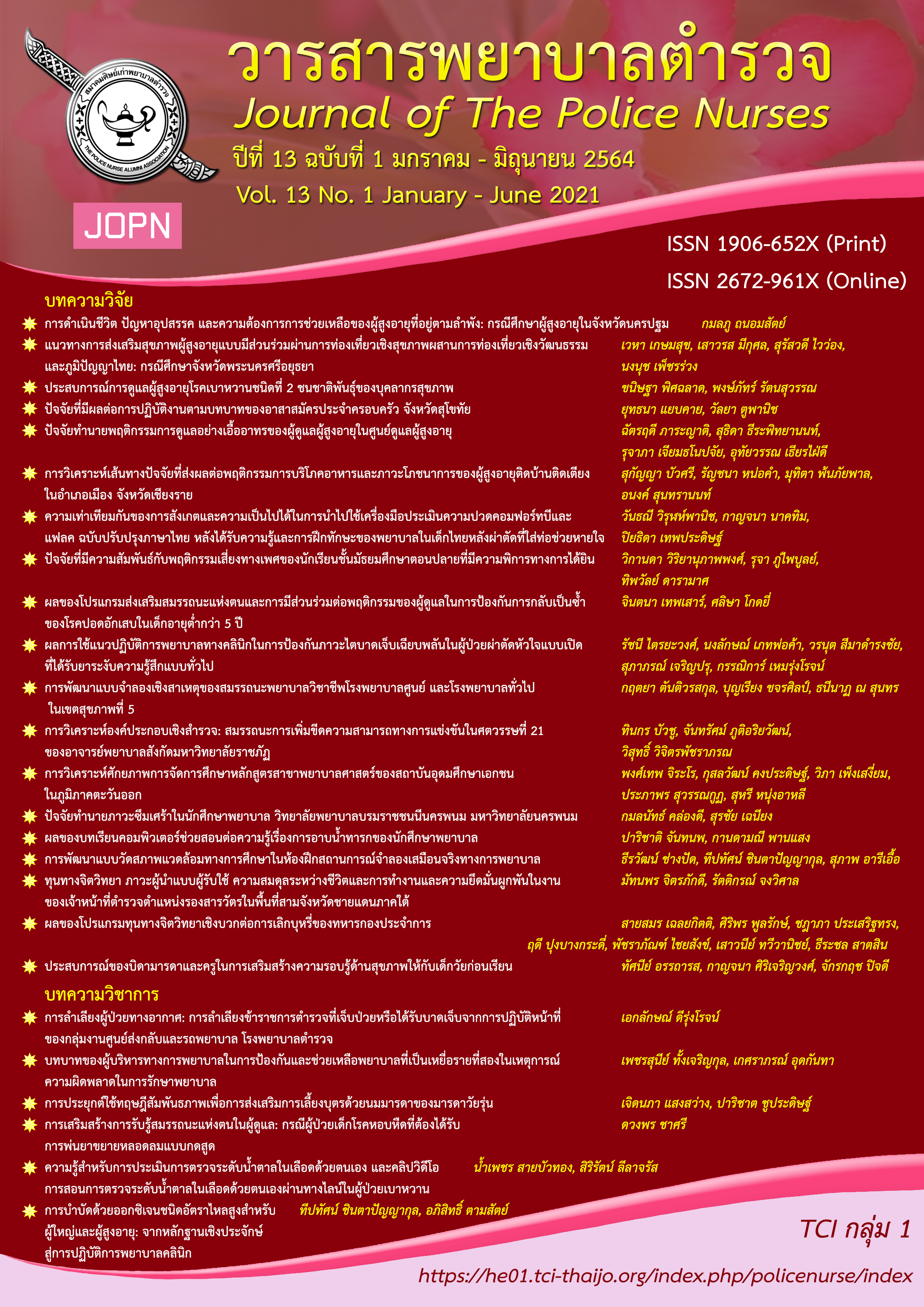THE THEORY OF ATTACHMENT FOR PROMOTING BREASTFEEDING AMONG ADOLESCENT MOTHERS
Keywords:
theory of relationship, breastfeeding, adolescent mothersAbstract
Adolescent mother-Infant interaction behaviors consist of 8 behaviors including 1) touch and tactile sense, 2) eye-to-eye contact, 3) voice, 4) odor, 5) body warmth, heat, 6) entrainment, 7) biorhythmicity, and 8) smiling (Baosoung, 1995). Mother-Infant interaction is the process of building mutual trust between the adolescent mother and the infant. The touches and interactions from the infant to the adolescent mother in the first hour after birth will promote the behavior of expressing love from the mother to her baby, resulting in more possibility for a successful initial period of breastfeeding that the mother would breastfeed for a longer period. Simultaneously, breastfeeding is a way to promote love and relationship between the adolescent mother and infant.
Downloads
References
Alianmoghaddam, N., Phibbs, S., & Benn, C. (2018). Reasons for stopping exclusive breastfeeding between three and six months: A qualitative study. Journal of Pediatric Nursing, 39, 37-43. https://doi.org/10.1016/j.pedn.2018.01.007
Baosoung, C. (1995). Support attachment between parents and infants. Textbook Obstetrics and Gynecology Nursing. Faculty of Nursing, Chiang Mai University.
Bramson, L., Lee, J. W., Moore, E., Montgomery, S., Neish, C., Bahjri, K., . . . Melcher, C. L. (2010). Effect of early skin-to-skin mother–infant contact during the first 3 hours following birth on exclusive breastfeeding during the maternity hospital stay. Journal of Human Lactation, 118(5), 1-8. https://doi.org/10.1177/0890334409355779
Britton, J. R., Britton, H. L., & Gronwaldt, V. (2006). Breastfeeding, sensitivity, and attachment. Pediatrics, 118(5), 1436-1443. https://doi.org/10.1542/peds.2005-2916
Edwards, R. C., Thullen, M. J., Henson, L. G., Lee, H., & Hans, S. L. (2015). The association of breastfeeding initiation with sensitivity, cognitive stimulation, and efficacy among young mothers: a propensity score matching approach. Breastfeeding Medicine, 10(1), 13-19. https://doi.org/10.1089/bfm.2014.0123
Faculty of Nursing, Mahidol University. (2013). Breastfeeding. Bangkok: Textbook Project of Faculty of Nursing, Mahidol University.
Gibbs, B., Forste, R., & Lybbert, E. (2018). Breastfeeding, parenting, and infant attachment behaviors. Maternal and Child Health Journal, 22(1), 103-114. https://doi.org/10.1007/s10995-018-2427-z
Hakularb, P., & Thananowan, N. (2009). Barriers of breastfeeding initiation in labor room. Thai Journal of Nursing Council, 24(2), 19-25. https://imsear.searo.who.int/handle/123456789/132487
Klaus, M. H., & Kennell, J. H. (2011). Care of parents. In M. H. Klaus & A. A. Fanaroff (Eds.), Care of high-risk neonate (5th ed., pp. 195-222). Philadelphia, PA: W.B. Saunders.
Lawrence, R. A., & Lawrence, R. M. (2011). Breastfeeding: A guide for the medical profession (7th ed.). Missouri: Elsevier.
Liu, J., Leung, P., & Yang, A. (2014). Breastfeeding and active bonding protects against children’s internalizing behavior problems. Nutrients, 6(1), 76-89. https://doi.org/10.3390/nu6010076
McLaughlin, M., Fraser, J., Young, J., & Keogh, S. (2011). Paediatric nurses’ knowledge and attitudes related to breastfeeding and the hospitalised Infant. Breastfeeding Review, 19(3), 13-24.
National Statistical Office. (2016). Survey of children and women in Thailand 2015-2016. Retrieved from https://mics-surveys-prod.s3.amazonaws.com/MICS5/East%20Asia%20and%20the%20Pacific/Thailand/2015-2016/Key%20findings/Thailand%202015-16%20MICS%20KFR_Thai.pdf
Nkala, T. E., & Msuya, S. E. (2011). Prevalence and predictors of exclusive breastfeeding among women in Kigoma Region, Western Tanzania: A community based cross-sectional study. Nkala and Msuya International Breastfeeding Journal, 6(17), 1-7. https://doi.org/10.1186/1746-4358-6-17.
Schafer, R., & Genna, C. W. (2015). Physiologic breastfeeding: A contemporary approach to breastfeeding initiation. Journal of midwifery & Women's health, 60(5), 546-553. https://doi.org/10.1111/jmwh.12319
Topothai, C. (2018). The disparity in breast milk and dramatic veil powder. Retrieved from https://waymagazine.org/milk-code/
Yakasem, P., & Chaiyasung, P. (2012). Effect of prenatal attachment promoting program on maternal-fetal attachment in teenage pregnant women. Journal of Nursing Science and Health, 35(3), 19-25.
Yuangthong, S., Sawatphanit, W., & Deoisres, W. (2012). The effect of breastfeeding promoting program for first-time postpartum mothers on breastfeeding duration and behaviors. The Public Health Journal of Burapha University, 7(2), 100-116.
Downloads
Published
How to Cite
Issue
Section
License
ผลงานที่ได้ตีพิมพ์แล้วจะเป็นลิขสิทธิ์ของวารสารพยาบาลตำรวจ















